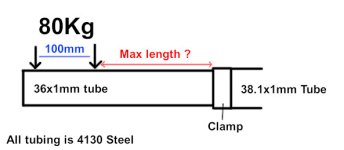Hello,
I'm working on a custom CLWB and could use some help figuring out the seat tube strength. If I bolt the seat on a 36x1mm horizontal insert tube, what's the max extension possible before it starts bending ? Thanks for your help;

EDIT: Here my findings so far:
Area Moment of inertia of the inner tube: pi×(36⁴−34⁴)÷64=16850.717595692mm2
Using that value and applying a force of 1000N (roughly 100Kg) on 4130 Steel (E modulus of 205000N.mm-2), I get
deflection = 1000×L³÷(3×205000×16850.718), where L is the distance to the clamp in mm
max stress = 36/2*1000*L/16850.718)
so 10cm from the clamp,
deflection = 1000×100³÷(3×205000×16850.718)= 0.1mm
stress = 36/2*1000*100/16850.718=106.82 N.mm-2 or MPa
With a given ultimate tensile strength 540 MPa - I'm fine
Now 20cm from the clamp,
deflection = 1000×200³÷(3×205000×16850.718) = 0.77mm
stress = 36/2*1000*200/16850.718 = 213.64 N.mm-2
Still safe!
And based on a yield tensile strength of 460 Mpa, the max distance before the tube starts to deform would be
460×16850.718÷(36÷2×1000) = 430mm
At that distance, it would still bend down by 7.7mm, which is a probably a bit much!
Anyone getting the same results ?
I'm working on a custom CLWB and could use some help figuring out the seat tube strength. If I bolt the seat on a 36x1mm horizontal insert tube, what's the max extension possible before it starts bending ? Thanks for your help;

EDIT: Here my findings so far:
Area Moment of inertia of the inner tube: pi×(36⁴−34⁴)÷64=16850.717595692mm2
Using that value and applying a force of 1000N (roughly 100Kg) on 4130 Steel (E modulus of 205000N.mm-2), I get
deflection = 1000×L³÷(3×205000×16850.718), where L is the distance to the clamp in mm
max stress = 36/2*1000*L/16850.718)
so 10cm from the clamp,
deflection = 1000×100³÷(3×205000×16850.718)= 0.1mm
stress = 36/2*1000*100/16850.718=106.82 N.mm-2 or MPa
With a given ultimate tensile strength 540 MPa - I'm fine
Now 20cm from the clamp,
deflection = 1000×200³÷(3×205000×16850.718) = 0.77mm
stress = 36/2*1000*200/16850.718 = 213.64 N.mm-2
Still safe!
And based on a yield tensile strength of 460 Mpa, the max distance before the tube starts to deform would be
460×16850.718÷(36÷2×1000) = 430mm
At that distance, it would still bend down by 7.7mm, which is a probably a bit much!
Anyone getting the same results ?
Last edited:





